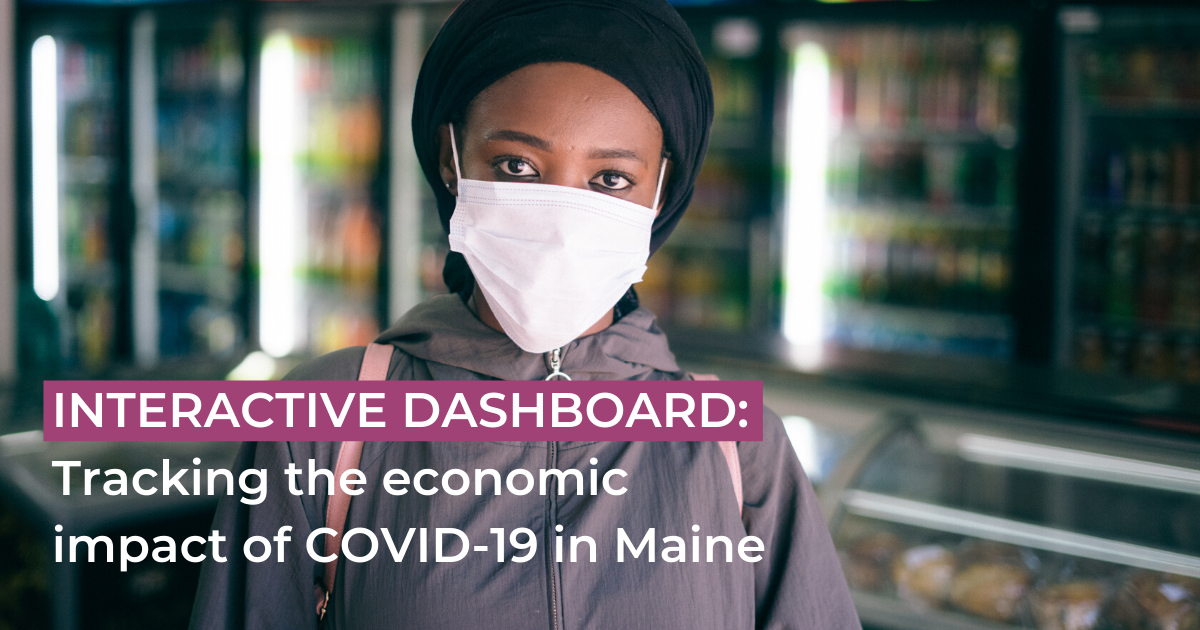MECEP is monitoring several short-term indicators to track the effect of the COVID-19 pandemic on Maine’s economy. Sources for each indicator can be seen in the descriptions below.
Indicator 1:
COVID-19 cases in Maine
The economic downturn is driven by a pandemic of the novel coronavirus, which sickens people with a disease known as COVID-19. The current scientific consensus indicates the coronavirus is spread by respiratory droplets, which are expelled by infected individuals when they breathe, talk, sing, shout, or laugh.
Normal economic activity — which generally requires close person-to-person interactions — is dangerous during an outbreak. We track COVID-19 cases because a resumption of normal economic activity remains dangerous as long as the virus is circulating and replicating in our state.
Source: Maine Center for Disease Control
Indicator 2:
Unemployment Compensation
Federal and state government have expanded eligibility for unemployment compensation during the COVID-19 outbreak. As a result, unemployment benefits are available to many more workers. Even accounting for this expanded eligibility, the need to close some businesses and limit many activities has led to an unprecedented number of temporary and permanent layoffs.
Continuing claims data represents the number of payments made to Mainers in the given week. An individual may receive more than one payment in a week if they are being paid for several weeks’ worth of claims at once.
Indicator 3:
Mainers at work
Tens of thousands of Mainers have lost work during the pandemic. While income losses have been mitigated by the expansion of unemployment benefits, these additional benefits are scheduled to expire on July 31. If the pandemic benefit programs are not extended, unemployed Mainers will face much more economic hardship. Some of these job losses will be permanent, while others will be temporary.
Measuring unemployment during the pandemic has been challenging because many workers are in an ambiguous employment situation. For example, they may be temporarily furloughed, or laid off and expecting to return to work soon for the same employer. The US Bureau of Labor Statistics has noted that the pandemic itself has made some of its usual data-gathering procedures more difficult.
Nonetheless, the monthly employment numbers showed an unprecedented decline in the number of individuals working in Maine. Many of these Mainers may be expecting to return to their jobs as the pandemic lifts, but others will be laid off permanently. The extent to which layoffs are temporary or permanent is as yet unclear.
DATA IN CONTEXT: In February 2020, the total civilian labor force in Maine was 695,000, of whom 22,000 were unemployed, and the remaining 673,000 were employed.
Indicator 4:
Food insecurity
Inability to purchase enough food to eat is one of the most telling indicators of economic hardship.
DATA IN CONTEXT: Immediately preceding the COVID-19 pandemic (the week of March 13), 47,000 Mainers said they lived in a household where there sometimes or often was not enough to eat. That’s according to respondents in the first week of the Census Bureau’s Household Pulse survey, a new tool used to measure Americans’ experiences during the pandemic.
Indicator 5:
Housing insecurity for renters
Housing insecurity for rentersLoss of income also puts many Mainers at risk of losing their homes. The Maine Housing Authority has set up a limited Rent Relief Fund for Mainers with low incomes, but many more individuals and families are still struggling to pay rent.
DATA IN CONTEXT: Towards the beginning of the economic downturn, 36,000 Maine renters could not make the prior month’s rent payment, according to respondents in the first three weeks of the household pulse survey (April 23 – May 19).
Indicator 6:
Housing insecurity for mortgage-holders
Mainers with mortgages risk going default or foreclosure if their income drops to the point that they can’t make their monthly payments. Forbearance, which allows mortgage holders to delay payments, is available to all Mainers with federally backed mortgages. Many banks are offering additional relief to homeowners.
DATA IN CONTEXT: Towards the beginning of the economic downturn, 21,000 Maine households with mortgages couldn’t make the prior month’s mortgage payment, according to respondents in the first three weeks of the household pulse survey (April 23 – May 19)
Indicator 7:
Temporary Assistance for Needy Families
Temporary Assistance for Needy Families is the main cash assistance program for parents of minor children with very low incomes.
Typically, in a recession, enrollment in all safety net programs increases, as individuals lose wage income and need assistance to meet basic needs. There is often a lag between increasing unemployment and increased program enrollment, since many of the newly unemployed may not immediately realize they are eligible for assistance. During the COVID-19 downturn, the expansion of unemployment benefits may have reduced the need for these programs, reducing any enrollment surge.
Indicator 8:
Food assistance
The Supplemental Nutrition Assistance Program helps individuals and families with low incomes afford food.
Typically, in a recession, enrollment in all safety net programs increases, as individuals lose employment income, and need assistance to meet their basic needs. There is often a lag between increasing unemployment and increased program enrollment, since many of the newly unemployed may not immediately realize they are eligible for assistance. During the COVID-19 downturn, the expansion of unemployment benefits may have reduced the need for these programs, reducing any enrollment surge.
Indicator 9:
Medicaid enrollment
Medicaid, administered in Maine as MaineCare, is available to adults and children with low incomes. MaineCare provides free access to a limited number of medical services.
Typically, in a recession, enrollment in all safety net programs increases, as individuals lose employment income, and need assistance to meet their basic needs. There is often a lag between increasing unemployment and increased program enrollment, since many of the newly unemployed may not immediately realize they are eligible for assistance. During the COVID-19 downturn, the expansion of unemployment benefits may have reduced the need for these programs, reducing any enrollment surge.




